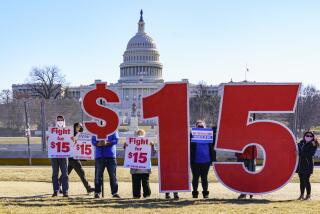Trickle-Down Was a Flop, So Try Trickle-Up : Raise the minimum wage and give the working poor buying power to boost the economy.
- Share via
The 1980s was a decade of trickle-down economics. During this period, the rich got richer, the poor got both poorer and more numerous (an additional 7 million people have fallen below the poverty line) and the middle class shrunk. While inflation has been brought under control, the unemployment rate still remains at about 5.6%. It might be time to think about developing a new economic theory.
Most of us are familiar with trickle-down economics: Large tax cuts will put more money into the hands of corporations and wealthy individuals who will invest in job-creating industries. The accumulation of wealth at the top will gradually trickle down to those at the bottom. But there are a lot of people at the bottom (and many in the middle) still waiting for the money to start trickling down.
I would like to propose a new economic theory, the “percolate-up” theory: The best way to stimulate the economy and increase the standard of living is to put more money into the hands of the poor. Countless studies have shown that poor people spend a greater proportion of their income than do rich people. More spending requires more production, more production requires more employment and this in turn will generate more demand, stimulate more production and create even more employment. Consumers, not producers, will generate the energy for economic growth. Thus the benefits of putting more money into the hands of the poor will gradually percolate up through the middle class and beyond.
But how do we put more money in the hands of the poor? The traditional way has been to increase government transfer payments (such as Social Security and welfare). But increased government spending will only add to the growing federal deficit, which is neither politically feasible nor financially wise.
An alternative is to raise the minimum wage, which would stimulate the economy without adding to the federal deficit. Indeed, raising the minimum wage should decrease the deficit because it would increase tax revenues and reduce the cost of government assistance to the poor.
There is no more serious condemnation of trickle-down economics than the fact that millions of adults working full-time still find themselves well below the poverty line.
Critics argue that an increase in the minimum wage would only add to unemployment and thus harm its intended beneficiaries. But there is surprisingly little empirical support for this contention. The results of research on the employment effects of an increased minimum wage are inconclusive. As recently as 1978, the real value of the minimum wage was more than $6 per hour. Currently it is $4.25 per hour. Yet we have not seen a corresponding decrease in the unemployment rate. An increase in the minimum wage, because of the additional spending it would generate, would have a positive effect on the level of employment.
As strange as this may sound, higher wages should actually be good for businesses. If employers had to pay more for labor, they would be forced to boost productivity by investing in modern equipment, making American goods more competitive. The strength of the U.S. economy during the booming post-war era was precisely this combination of increasing wages and growing productivity. The availability of a large pool of low-wage workers, however, gives business the option of competing in the world market by cutting labor costs rather than increasing productivity. This is why trickle-down doesn’t work. An increase in the minimum wage would compel employers to make productivity-enhancing investments.
Most economists agree that the U.S. economy suffers from inadequate productive investment. The reason for this insufficient investment, according to trickle-downers, is a shortage of capital. Their solution is to make capital more available to potential investors by increasing savings, decreasing consumption, cutting taxes and keeping wages low.
The problem is not a lack of capital, but a lack of profitable investment opportunities. And profitable opportunities are lacking because the demand for goods and services has not kept pace with the growth in productive capacity. The percolate-up theory suggests that we deal with this problem by augmenting demand, for businesses expand production and add jobs only if they can reasonably expect to sell what they produce. Thus instead of tax breaks for the rich, what we need is an increase in the minimum wage.
Real wealth is created at the bottom. But should the percolate-up theory prove as faulty as the trickle-down theory, at least this time, it will be the poor, not the rich, who would benefit.
More to Read
Inside the business of entertainment
The Wide Shot brings you news, analysis and insights on everything from streaming wars to production — and what it all means for the future.
You may occasionally receive promotional content from the Los Angeles Times.










